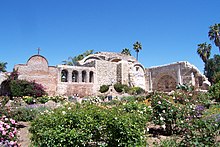
Back البعثات الإسبانية في كاليفورنيا Arabic Spanische Missionen in Kalifornien German Misiones españolas en California Spanish Espanjan lähetysasemat Kaliforniassa Finnish Missions espagnoles de Californie French Missioni spagnole in California Italian カリフォルニア・ミッション Japanese Missiones Californiae Latin Spaanse missies in Californië Dutch Испанские миссии в Калифорнии Russian

Part of a series on |
| Spanish missions in the Americas of the Catholic Church |
|---|
 |
| Missions in North America |
| Missions in South America |
| Related topics |
|
|

The Spanish missions in California (Spanish: Misiones españolas en California) formed a series of 21 religious outposts or missions established between 1769 and 1833 in what is now the U.S. state of California. The missions were established by Catholic priests of the Franciscan order to evangelize indigenous peoples backed by the military force of the Spanish Empire. The missions were part of the expansion and settlement of New Spain through the formation of Alta California, expanding the empire into the most northern and western parts of Spanish North America. Civilian settlers and soldiers accompanied missionaries and formed settlements like the Pueblo de Los Ángeles.[2]
Indigenous peoples were forced into settlements called reductions,[3] disrupting their traditional way of life and negatively affecting as many as one thousand villages.[2] European diseases spread in the close quarters of the missions, causing mass death.[4] Abuse, malnourishment, and overworking were common.[5] At least 87,787 baptisms and 63,789 deaths occurred.[6] Indigenous peoples often resisted and rejected conversion to Christianity.[7] Some fled the missions while others formed rebellions.[7] Missionaries recorded frustrations with getting indigenous people to internalize Catholic scripture and practice.[7] Indigenous girls were taken away from their parents and housed at monjeríos.[8] The missions' role in destroying Indigenous culture has been described as cultural genocide.[5]
By 1810, Spain's king had been imprisoned by the French, and financing for military payroll and missions in California ceased.[9] In 1821, Mexico achieved independence from Spain, yet did not send a governor to California until 1824. The missions maintained authority over indigenous peoples and land holdings until the 1830s. At the peak of their influence in 1832, the coastal mission system controlled approximately one-sixth of Alta California.[10] The First Mexican Republic secularized the missions with the Mexican secularization act of 1833, which emancipated indigenous peoples from the missions. Mission lands were largely given to settlers and soldiers, along with a minority of indigenous people.[7]
The surviving mission buildings are the state of California's oldest structures and most-visited historic monuments, many of which were restored after falling into near disrepair in the early 20th century. They have become a symbol of California, appearing in many movies and television shows, and are an inspiration for Mission Revival architecture. Concerns have been raised by historians and Indigenous peoples of California about the way the mission period in California is taught in educational institutions and memorialized.[8] The oldest European settlements of California were formed around or near Spanish missions, including the four largest: Los Angeles, San Diego, San Jose, and San Francisco. Santa Barbara, and Santa Cruz were also formed near missions, and the historical imprint reached as far north as Sonoma in what became the wine country.
- ^ Saunders and Chase, p. 65
- ^ a b Hull, Kathleen L.; Douglass, John G., eds. (2018). Forging communities in colonial Alta California. Tucson: University of Arizona Press. p. 14. ISBN 978-0-8165-3892-8. OCLC 1048786636.
- ^ O'Mara, Richard (Spring 1999). "The Jesuit Republic of South America". VQR Online. 75 (2). Archived from the original on Oct 24, 2020. Retrieved 2020-07-10.
- ^ Cite error: The named reference
:3was invoked but never defined (see the help page). - ^ a b Cite error: The named reference
:4was invoked but never defined (see the help page). - ^ Cite error: The named reference
:0was invoked but never defined (see the help page). - ^ a b c d Kling, David W. (2020). A history of Christian conversion. New York, NY: Oxford University Press. pp. 344–345. ISBN 978-0-19-006262-0. OCLC 1143823194.
Apart from a tiny minority who gave the clearest evidence of meaningful conversion... Overall, outright rejection and chronic resistance characterized the Indian response. [...] The Franciscans admitted as much, recording repeatedly the difficulty of convincing adult Indians to accept any aspect of Catholicism.
- ^ a b Vaughn, Chelsea K. (2011). "Locating Absence: The Forgotten Presence of Monjeríos in Alta California Missions". Southern California Quarterly. 93 (2): 141–174. doi:10.2307/41172570. ISSN 0038-3929. JSTOR 41172570.
- ^ Duggan, MC (2016). "With and Without an Empire: Financing for California Missions Before and After 1810" in Pacific Historical Review, Vol. 85, No. 1, pp. 23–71. Duggan, M. C. (2016). "With and Without an Empire: Financing for California Missions Before and After 1810". Pacific Historical Review. 85 (1): 23–71. doi:10.1525/phr.2016.85.1.23. Archived from the original on 2018-04-27. Retrieved 2018-03-05.
- ^ Robinson, p. 25